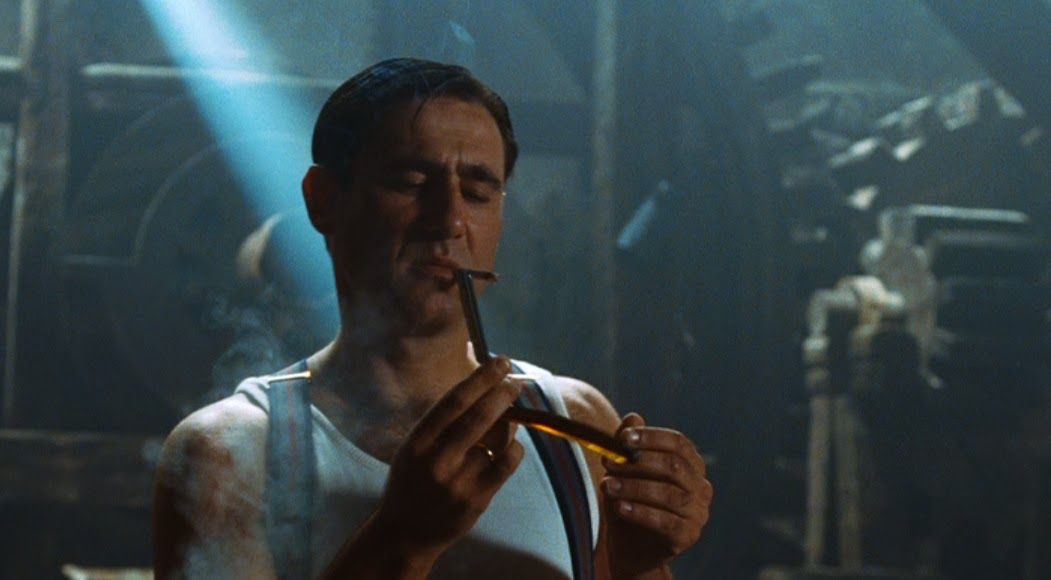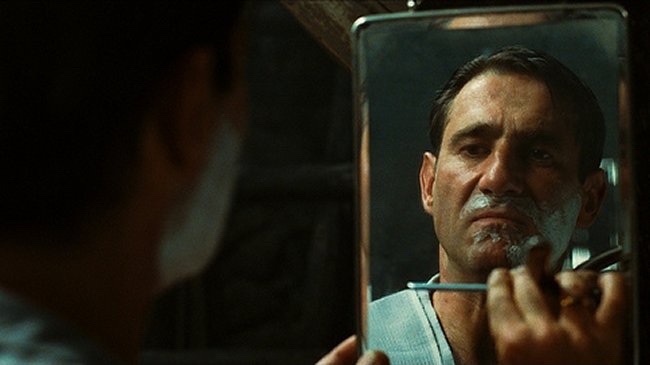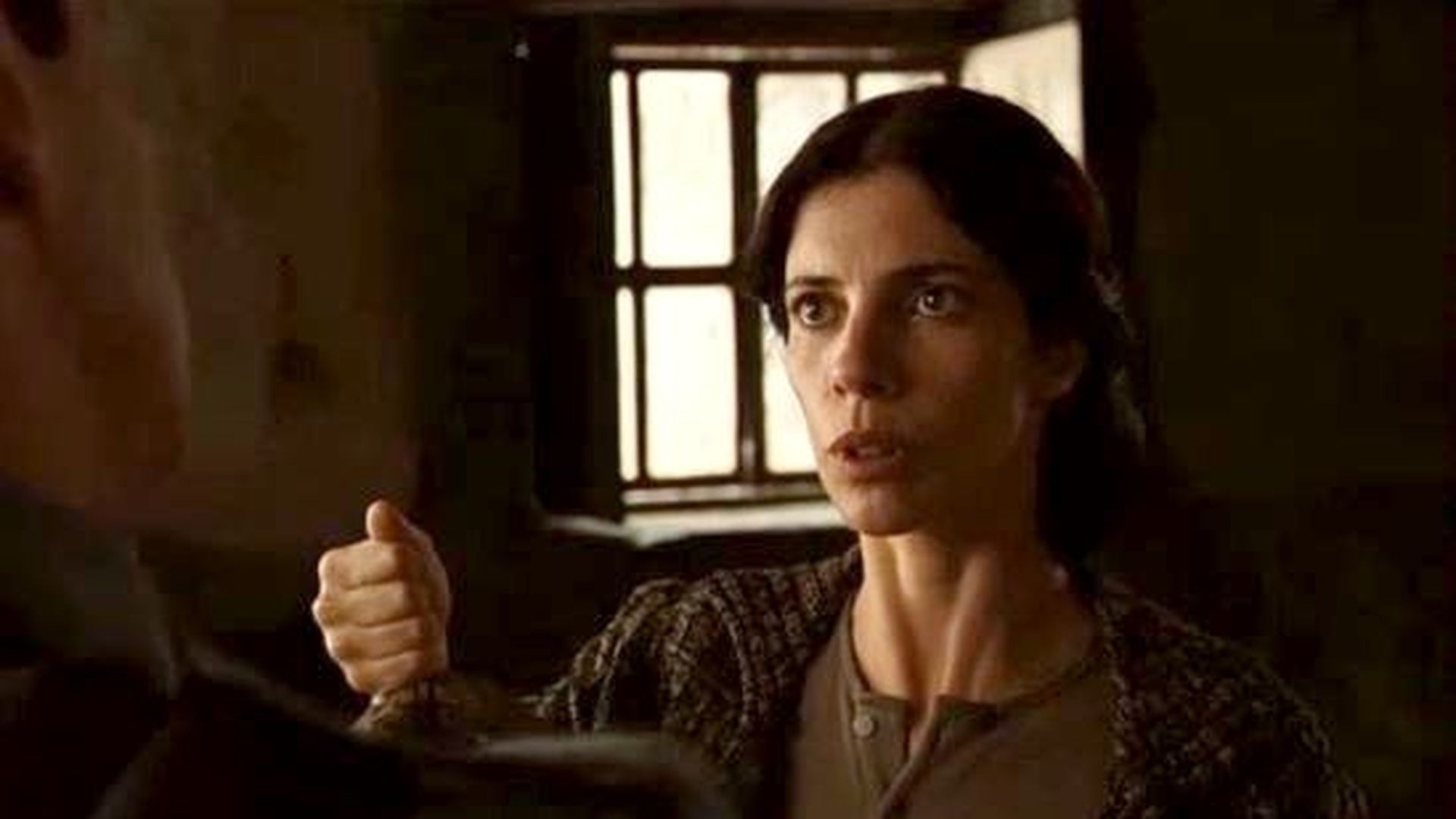Mise-en-scen:
The razor that the Captain holds is sharp and imposing, a clear symbol of his tendency for violence and aggressive solutions, whether for dealing with rebels or shaving. The ring is on his left hand, which may be means to symbolise Vidal’s false love for his wife. The gramophone he plays music on is showed to display his wealth, and contrasts him to the peasants shown in the rest of the film. This establishes the power he holds over the area and the rations. Throughout the shaving sequence, Vidal has no uniform on, which signals two the audience that he is alone and in a truly private moment, but even here he carry’s himself with dignity and pride, as he is that obsessed with image and integrity as a military leader.
The cigarette also shows Vidal’s control of luxury resources like tobacco, and the smoke illuminated by the light coming into the basement hangs around his head gives him an intimidating presence, almost like smoke steam from the nose of a stag. The cigarette is also shorter after a hidden cut, which shows a passage of time. The many scattered and stacked papers at Vidal’s desk show his efficiency and attentiveness to his work, and the various shaving equipment also hints at his obsession with maintaining a clean and pristine appearance.

The cogs and mechanisms that are seen in the background of the basement are symbolic of Vidal’s efficiency and machine-like personality. He has no emotion, only an end goal and mission to destroy the rebels. This shows that he is a truly cruel and viscous villain to the otherwise fairy-tale aspects of the story, like a human form of the various monsters seen in the rest of the movie.
The boot that Vidal polishes is very shiny and clean, and this signify that it was probably expensive and also signify, again, the Captains attentiveness to how he looks, and his pride in being a Captain. This is also seen in how tidy and neat his uniform is, especially in contrast with the more humble and simple design of Mercedes’ and the kitchen staff outfits. The dining table is long, which shows that it was likely expensive (it also eludes to the later one “place man” sequence, showing how much of a monster Vidal is) and the mug is large and the fireplace completely stocked with wood, and also big and imposing. This all contributes to subtly signalling to the audience the military’s, or more specifically the Captains control over the ration’s and resources and money in this area of Spain, and his power that comes with being a military official in a fascist country. This can also be seen with the amounts of buckets and food in the kitchen.

Cinematography:
There is a close-up of the gramophone to bring attention to it and the Captains hand, which the camera then follows upwards until it lands on Vidal’s face. There is a mid-shot here to make room for the razor, Vidal’s face, and the light coming into the basement behind him. This is also a low-angle shot, looking up at Vidal to make him seem more intimidating and imposing to the audience. The shot here almost looks like a portrait, the light giving a biblical sense to the image, and the razor a symbol of Vidal’s violence and power. This shows the Captains inflated perception of himself and his status as a Captain.
The camera then moves from a mid-shot to a long-shot as Vidal walks towards the mirror. This allows for us to see the entire basement and his position in the centre of it. This symbolises his authority and status in the centre of the mill as the Captain, and also his small part in a much bigger fascist machine. The camera then arches around the mirror to push into a close-up of the Captains face as he shaves, forcing the audience to get closer to him and see the precision with which he shaves, how he has no hesitation in using a dangerous razor, and how impassive he looks as he does it, a reference to the face he made as he killed the farmers earlier, calm and casual.

A glance object shot shows us all of the equipment that the Captain us using to shave, showing, again, his particular carefulness with creating an appearance. Once the Captain is in the dining room, the lighting is hazier and warmer, a sharp contrast to the cold and metallic environment of Vidal’s room. This also eludes to the contrast between Vidal and Mercedes as characters. The camera pedestals up as Vidal stands, which shows how much taller he is than Mercedes.
This is re-enforced when we cut to an over-the-shoulder shot of Vidal leaning down to intimidate Mercedes, which shows how imposing and threatening he is physically. This shot is also very tight, which creates a feeling of claustrophobia and fear in the audience, of Vidal. The camera then cuts to a wide-shot to show the entrance to the kitchen and how Vidal menacingly stared at Mercedes as she leaves. Only we, the audience, see this, so only we know that he may have suspicions of, or dark intentions for her.
Sound:
The non-diegetic sound of the gramophone picks up in the mix as Vidal turns it on. The audio is loud and slightly scratchy, which immerses the audience in the time period. The music is also very grand and patriotic in nature, which shows Vidal’s sense of patriotism and self-pride/image. The razor produces diegetic sounds that are sharp and sudden. This establishes how sharp the razor is and therefore how much danger Vidal is putting himself in by using it. It also puts the audience on edge slightly, since it is an unpleasant and rough sound that makes the audience feel uncomfortable, which they are supposed to with Vidal on screen, since the is so menacing.
The music also comes to a climax as Vidal begins shaving , which shows how he views this simple activity as a sort of symbol of his power, authority and masculinity. The grand and powerful tone of the music symbolises his obsession with how he presents himself and how he goes about completing his mission. The complexity and liveliness of the music also serves as a stark contrast to Vidal’s otherwise passive and calm expression.

No music is played when Vidal is in the dining room. This creates tension and keeps focus on what he and Mercedes are saying. It also makes what seems like a vaguely awkward conversation come across as a lot more intense and threatening, as the awkward silence combines with the Captains terrifying demeanour to evolve into a disturbing silence that hangs in the air as thick as fog. This all emphasises the fear that Vidal creates in the audience, and the effect on the people around him, including Mercedes, who’s perspective we see here. As Mercedes enters the kitchen, there are many diegetic sounds of metal and glass inserted to emphasise how busy the staff are, and also the amount of rations they have, and immerses the audience in the environment, of only for a few moments.
Performance:
As Vidal goes about the basic task of shaving his face, he seems to be taking great care and joy even in it. This is seen in how he carry’s himself around the room confidently, asserting his power over the environment. His movements are fluid and constant, showing how much pride he takes in maintaining his appearance. The seriousness and attentiveness with which Vidal shaves his face eludes to how he goes about his work as a Captain, efficient and concentrated. The face he makes as he looks in the mirror is also very similar to the one he made as he killed the farmer’s son earlier, showing that he truly had no regret or remorse/hesitation as he murdered that man.
He also makes the activity of shaving almost like a ritual, in the way that he plays music and apples the cream with a brush, carefully studies the blade before using it, smokes and study’s his face in the mirror, and uses a hot towel to get ready. This all contributes to our perception of the Captain, and how he seems so obsessed with himself, his country, career and appearance. This is also seen in the dining room as he intently stares at his boot as he cleans it.
Mercedes answers back to the Captain, which eludes to her role as a rebel, and also her silent disdain and hatred for the Captain. He responds by asserting himself by standing up and placing a hand on her shoulder. This solidify Vidal as a threatening and dominant figure who is fine with keeping people in line by using fear as a tactic. Mercedes’ concerned expression shows this. The way that the kitchen staff also seem happy and even joke when not in the presence of the Captain creates a less tense and uncomfortable atmosphere, emphasising the effect that Vidal has on people by creating that same effect on the audience.

Editing:
The scene is done in a lone-take until the camera crabs behind a pillar in the basement. As it passes through the darkness, a hidden cut is made, since when it emerges time has passed and the cameras is in a new location. This makes the shaving sequence almost seem like one long cut, which makes the various cuts seamless and un-noticeable. This keeps all focus on the Captain, and also makes the pacing of the scene match the fluid and precise movements of the Captain match each other. The pacing also matches up to the intense and fast music, and keeps the audience up to speed with the course of events in this scene, as we understand them to be continuous, which makes this continuity editing.
There is also another hidden cut when the camera moves behind the Captains head. This could be done to ssymbolise the fact that we, the audience, do not know what goes on inside Vidal’s head, what his inner-thoughts are, which makes him all the more terrifying. It also then brings us into a wide-shot of the basement, but then the scene cuts to the kitchen. The cuts that show a passage of time make this temporal editing, done to progress the story and keep the basic scene of Vidal shaving brief and filled with symbolism, not content, and progress the story more. A cut is possibly used here to end the fluid and constant movement/pacing of the scene before and brings the audience into the new environment. There are few cuts from here, as the shaving sequence is over and now Vidal is not alone, and the focus of the scene has switched from him to Mercedes, which is done by leaving Vidal off-screen as she leaves into the kitchen.
You must be logged in to post a comment.